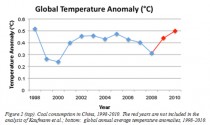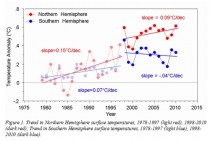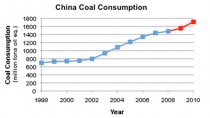By Patrick J. Michael, Senior Fellow in Environmental Studies at the Cato Institute
Boston University’s Robert Kaufmann and colleagues recently published a paper in the Proceedings of the National Academy of Sciences examining the causes of the recent dearth of “global warming.” They concluded that it’s simply natural variability, augmented by increasing sulfate emissions from dramatically growing coal consumption by China.
Of course, it is the latter conclusion that has drawn all the attention, for it allows the possibility that greenhouse gases are continuing to impart an as-expected warming influence on the global climate. And then once China gets its air pollution under control (and we are talking about true air pollution here, i.e., not carbon dioxide), global temperatures will rise rapidly. Thus the dream of alarming climate change lives.
If China’s sulfate emissions are not having much of an impact of global temperatures, then, the dearth of warming in recent years supports the hypothesis — now made by many (unpopular) folks in the climate business — that the “sensitivity” of temperature to carbon dioxide has been guessed (we choose our words carefully here) to be too high by climate modelers. In this scenario, we wake up from the alarmist nightmare and resume our normal lives.
There are two reasons why we think it is wrong for Kaufmann et al. to attribute a reduced rate of global warming to Chinese sulfates:
1) China’s cooling sulfates do not readily make their way into the Southern Hemisphere, yet, from 1999-2010, temperatures actually fell there, while they rose in the Northern Hemisphere. This is exactly the opposite of what should have happened if sulfates are exerting a relative cooling primarily in the Northern Hemisphere
2) Chinese coal consumption increased in 2009 and 2010 (in fact, 2010 had the biggest year-over-year increase recorded) — yet, the global temperature rose sharply in 2009 and in 2010. Because Kaufmann’s climate model responds instantaneously to sulfates (as opposed to a decades-long lag to adjust to carbon dioxide changes) this is contrary to his hypothesis.
Let’s look at the first one.
The link below shows the march of weather systems around the globe for several months. Notice that the weather systems passing through China quickly move into the north Pacific Ocean, and don’t mix into the Southern Hemisphere. Since sulfates only have an atmospheric lifetime of about a week or so, they are hard pressed to cause any cooling impact beyond the areas to the immediate east of China.
So, if a dramatic increase in Chinese sulfur emissions during the past decade or so has been responsible for the observed slowdown in the rate of global temperature increase, then the Northern Hemisphere should be doing most of the work - that is, the rate of warming in the Northern Hemisphere should have slowed by much more than the rate of warming in the Southern Hemisphere. This situation is easy to check.
Figure 1 shows the Northern and Southern Hemisphere temperature history from 1980 through 2010 according to the surface temperature data set compiled and maintained by the Climate Research Unit at the University of East Anglia. During the period of time during which Chinese sulfate emissions rose (1998-2010), the warming in the Southern Hemisphere went negative (i.e. became a cooling) while the Northern Hemisphere warmed. From Figure 1 it is obvious that the Southern Hemisphere is driving the global temperature slowdown, not the Northern - a result completely contrary to Kaufmann et al.’s Chinese sulfate hypothesis.
Now let’s turn to our Reason #2. Simply put, during the past 2 years (which were not part of the Kaufmann et al. dataset), global temperatures rose as did Chinese coal consumption. According to Kaufmann et al.’s hypothesis, the increase in Chinese coal consumption should act to drive down the rate of global temperature rise, but that is not what happened. Again, temperatures are behaving in an opposite fashion, compared to what the hypothesis predicts.

Enlarged.
The top panel in Figure 2 shows Chinese coal consumption from the BP Statistical Review of World Energy from 1998 through 2010. Notice that it increased substantially in both 2009 and 2010 - two years not included in the Kaufmann et al. analysis. The year-over-year increase from 2009 to 2010 was the highest annual increase on record. If Chinese coal consumption were having a large impact on global temperature, we would expect that global temperatures would remain suppressed in 2009 and 2010. But the bottom panel in Figure 2 shows what really happened - global temperatures rose in both 2009 and 2010, contrary to the Kaufmann et al. hypothesis.
It is clear that natural variability, not sulfate emissions, is the cause of the lack of recent warming. We arrived at this very same conclusion several years ago, however, despite repeated attempts, we were unable to find a journal even interested in considering our work for publication.
Our analysis was remarkably similar to Kaufmann’s:
a) in previous work, we both built (and published) a statistical model relating global temperature change to elements of natural variability (including El Nino, volcanoes, and solar variability) and anthropogenic forcing;
b) in our new papers, we used that same (published) statistical model, but updated the independent variables (natural variability and anthropogenic forcing) with recently available data;
c) we used the updated independent variables to “forecast” the dependent variable, global temperature from 1998-2007 (in our case) or 1999-2008 (their case)
d) we concluded that our model developed from the pre-1998 data worked quite well using the post-1998 data — i.e., the global temperature response since 1998 was just what we would expect it to be, based on what it was in the couple of decades immediately prior to 1998;
e) we both arrived at the same take home message:
Kaufmann et al. (2011):
[W]e find that recent global temperature records are consistent with the existing understanding of the relationship among global surface temperature, internal variability, and radiative forcing, which includes anthropogenic factors with well known warming and cooling effects.\
Our paper (2008):
We find that the combined forces of “natural” variations in ENSO, solar activity and volcanic eruptions have acted to temporarily offset the continued pressure exerted by “global warming” [which we defined as “from anthropogenic activities, or from some other not-yet-fully-understood processes"]
The only difference between the manuscripts was Kaufmann’s unsupportable hypothesis that Chinese sulfate emissions also contributed to the lack of warming.
Our experience with the peer-review process was a nightmare that eerily resembles what University of Guelph’s Ross McKitrick describes in his chapter “Bias in the Peer-Review Process,” in my new book, Climate Coup.
We started with the American Geophysical Union’s (AGU) publication EOS, Transactions of the American Geophysical Union. After sitting on the paper for several months (which included getting a review or two), the EOS editors told us that we had too much “new” science in our piece and that EOS was more of a news publication and that they’d be happy to consider publishing a description of our work after it was published elsewhere:
Here is a review that they got concerning our submission:
I have carefully read and reread this proposal. Must say that I am surprised that the 2nd author [Patrick Michaels] is now stating that global warming is alive and well, and implicitly supports the view that anthropogenic activities, especially greenhouse gas accumulation in the atmosphere and ocean is the cause of current global warming trend. Eos readership would find the overall argument interesting, especially from the 2nd author.
However, the authors propose to carry out new analysis using a version of a previously published methodology/model. Hence, in my view, such analyses should be submitted as a research paper in a peer reviewed journal and rather than Eos. I admit that I have not chased the previously published methodology to ascertain the validity or otherwise of the proposed new analysis.
And here is their final decision:
I have consulted with several Eos editors, and one problem with this submission is the presentation of any new data. As stated earlier Eos is not an appropriate outlet for publishing new data. However, we would be very much open to publishing reinterpretation of **published** data or analysis.
Therefore, we stand by our earlier decision that after you publish the original research in a peer-reviewed journal that you come back to us with a proposal for writing something for Eos that would be written for the broad spectrum of disciplines represented by our readership.
OK, fine. Since the paper describing our original model (Michaels and Knappenberger, 2000) was published in another AGU publication, Geophysical Research Letters, we figured we submit our new paper there, after expanding the piece from the original EOS submission to a paper more appropriate for GRL. In our cover letter to GRL, we included our full set of correspondence with the editors of EOS, and explained how EOS was potentially interested in our findings, but considered there to be too much “new” science for it to be published there. We also included the reviewer’s comments that Eos had obtained (and reproduced above) including “Eos readership would find the overall argument interesting, especially from the 2nd author.”
Here is what we got back from the GRL editor, one day after submission:
I have evaluated your paper, 2008GL035428, and determined that it is not the type of high-impact contribution that warrants rapid publication in a letters journal such as Geophysical Research Letters. Of course the topic of your work is of critical importance. However, I believe that your analyses are too simplistic relative to others published in GRL. As such I am returning your paper without review.
Interesting. Too much new science for one AGU publication, too little for another.
So we turned to a journal which has a section dedicated to short science pieces with broad interest - we reworked our article and submitted it as a Brevia piece to Science magazine.
A week later we got this:
Thank you for submitting your manuscript “Did Global Warming Stop in 1998?” to Science. Because your manuscript was not given a high priority rating during the initial screening process, we will not be able to send it out for in-depth review. Although your analysis is interesting, we feel that the scope and focus of your paper make it more appropriate for a more specialized journal. We are therefore notifying you so that you can seek publication elsewhere.
Well, we figured Science was a long shot.
At the same time, we had received several emails soliciting/inviting us to submit a paper to a new journal titled Advance in Meteorology - a journal that was looking for content to get it off the ground:
I am writing to invite you to submit an article to the newly launched Advances in Meteorology, which aims to provide a rapid forum for the dissemination of original research articles as well as review articles in all areas of meteorology.
We figured, we had a paper basically ready to go for them. So, we redrafted it to fit the submission guideline to Advance in Meteorology, and sent it off.
About a week later we got this:
Following the review of your Research Article AMET/746854 titled “Did “Global Warming” Stop in 1998?,” by Patrick J. Michaels and Paul C. Knappenberger, I regret to inform you that it was found unsuitable for publication in Advance in Meteorology.
The major reasons are that this topic is discussed elsewhere (e.g. IPCC 2007), the statements are too general and simplified, the methods not appropriate to address the question of detection and attribution at such short time scales. Further, the analysis does not include other relevant factors, such as oceanic components, that have been shown to be of importance to account for continental to global warming. Also important other features at intra to interannual time scales are missing. The period is too short for a good model calibration/verification and to derive statistical sound results.
The complexity of this kind of analysis, in this case applied to decadal scale predictions are presented in Keenlyside et al. (2008, Nature, 453, 84-88). They have also hindcast experiments using different forcings to explain current conditions.
Ok, well, at least we got some scientific feedback, all of which was irrelevant. Our empirical model was built using monthly data over a time period of 20 years, fit the observed temperatures pretty well (the explained variance was about 60%) and it had already been published in Geophysical Research Letters. We were merely using it to understand the recent lack of warming.
Before giving up completely, we thought that we’d give it on more go, this time at the journal Climate Research, where we had published a half dozen or more papers in the past. About a week after submission, we got this response:
We have looked through the manuscript (ms) ‘Did “global warming” stop in 1998?’ that you recently submitted for publication in Climate Research.
While the information reported might be interesting, I regret to inform you that we cannot consider your ms for publication. We did not find your scientific arguments very convincing.
Climate Research was the journal that the climategaters particularly hated. They hatched plans to destroy it every time it published something they didn’t like, and I am sure these leaked all over the porous world of climate science. Perhaps their campaign worked.
We don’t know how to explain the glib acceptance of a very similar paper in the Proceedings of the National Academy of Sciences (with the exception of the obviously wrong hypothesis about Chinese sulfates), and our going 0-for-5. But that is the way it is.
References:
BP Statistical Review of World Energy 2011
Hansen, J., et al., 2005. Efficacy of climate forcings. J. Geophys. Res. 110, D18104, doi:10.1029/2005JD005776.
Kaufmann, R. K., et al., 2011. Reconciling anthropogenic climate change with observed temperature 1998–2008. Proceedings of the National Academy of Sciences. doi: 10.1073/pnas.1102467108
Michaels, P.J., and P.C. Knappenberger, 2000. Natural signals in the MSU global temperature record. Geophysical Research Letters, 27, 2905-2908.






